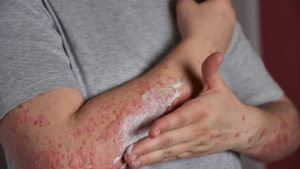Toxic epidermal necrolysis (TEN) is a serious skin Disorder that can be fatal. This is an uncommon illness in which the skin becomes extremely sensitive to some drugs or diseases. A person with TEN basically has skin that begins to peel off. It starts with flu-like symptoms like Fever and coughing followed by a sudden breakout of painful blisters and a large-scale peeling off of the skin.
Simply put, the body’s immune system attacks the skin cells, going into overdrive and causing this skin reaction. It appears as though the body’s defensive mechanism becomes disoriented and begins attacking its own skin. Widespread skin damage results from this separation of the skin’s upper and lower layers.
Due to its potential to become life-threatening, Toxic epidermal necrolysis is frequently seen as a medical emergency. When the skin deteriorates, the body becomes more susceptible to dangerous illnesses because the skin acts as a barrier against infection. Furthermore, significant fluid loss and issues controlling body temperature might result from skin loss.
To treat Toxic epidermal necrolysis, the medicine that caused the response is often stopped, and symptoms are managed with supportive care. This could involve treating pain, replacing lost fluids, and occasionally using specialized therapies such as immunoglobulins or steroids to suppress the immune system.
The process of recovering from Toxic epidermal necrolysis can be difficult and long-standing. It often requires immediate medical attention and may cause problems or long-lasting scars.
The Skin Disorder of Toxic Epidermal Necrolysis is a devastating skin condition marked by blistering and extensive skin destruction. The skin becomes extremely painful, puffy, and red, almost like a bad burn. Even though TEN can be fatal, many patients can recover and regain their health with the right care.
It can occur unexpectedly and travel quickly throughout the body, which makes it quite dangerous. Individuals who have TEN may have intense burning or itching of the skin.
Toxic epidermal necrolysis is extremely uncommon, but because it can be fatal, it is critical to identify it as soon as possible. Getting medical attention as soon as possible is vital if you or someone you know begins to exhibit these symptoms. To slow the progression of the sickness and promote skin healing, doctors might administer specialized care for Toxic epidermal necrolysis.
Understanding some facts about skin

Do you know that your skin helps as more than simply a protective layer for your body?
Your skin is beyond the concept of skincare or being glowing, it has great properties that benefit human health.
It is your largest organ. Consider it your personal shield from the elements and any threats.
Your skin accomplishes so much more than just look pretty. Its primary function is to control your body’s temperature, imagine it as your own personal thermostat. Sweating allows you to release heat when you are feeling so, and stay warm when you are cold.
But there’s still more! Another storage unit is your skin. It provides insulation to keep you warm and hangs onto fat and water to keep you hydrated. Furthermore, did you know that it has a ton of sensors? Yes, your skin functions similarly to an inbuilt radar system, continuously informing your brain about events occurring in your environment. It is the way you experience pressure, touch, and even pain.
This is where it gets really interesting now. Your skin acts as both a factory and a barrier to the outside world. Your skin goes into production mode while you are outside enjoying the sun, producing vitamin D like it’s going out of style.
The next time you enjoy sun exposure, thank your skin for providing you with important vitamin D for strong and healthy bones.
However, here an important thing to note is, that the worst part is that not all skin is made equal. Your skin is distributed throughout your body in a collaged pattern, varying in thickness, color, and texture. Speaking of feet, did you know that your palms and soles have far thicker skin than the rest of your body? It’s as if the natural world is trying to protect you more in those busy places.
Now you know the importance of skin, just imagine how the human body would feel when the skin is disturbed or sick.
Nonetheless, coming back to Toxic epidermal necrolysis, let us explore further!
Symptoms of Toxic epidermal necrolysis
Fever, sore throat, and coughing are common flu-like symptoms that precede TEN symptoms. Subsequently, there is an abrupt start to skin rashes and blisters, which quickly escalate into a large-scale skin separation. Similar to severe burns, the damaged skin may seem red, puffy, and painful.
Treatment of Toxic Epidermal Necrolysis
In an intensive care unit or specialist burn unit, TEN patients need to receive medical assistance right away. The main objectives of treatment are to control symptoms, avoid complications, and halt the condition’s progression. This could involve stopping the suspected drug, providing supportive care including fluid replenishment and pain relief, and occasionally immunomodulatory therapy.
Who is at risk of Toxic Epidermal Necrolysis?
Although TEN can afflict people of any age, adults are more likely to experience it. There is a link between a higher chance of getting TEN and some drugs, especially those that are known to produce severe skin responses. It is important to remember, though, that infections or underlying medical disorders can also cause Toxic epidermal necrolysis.













